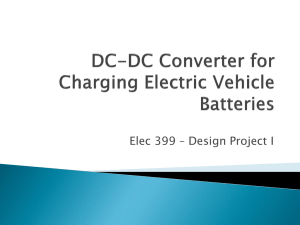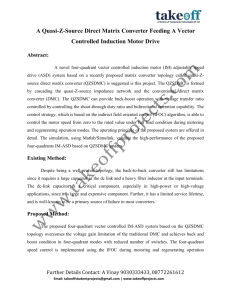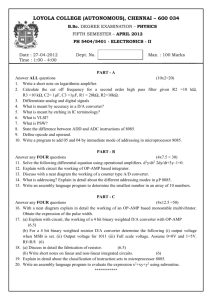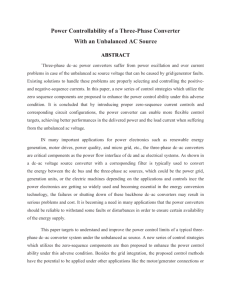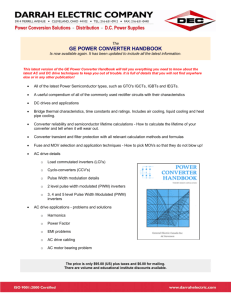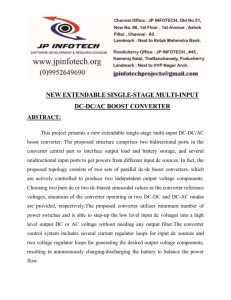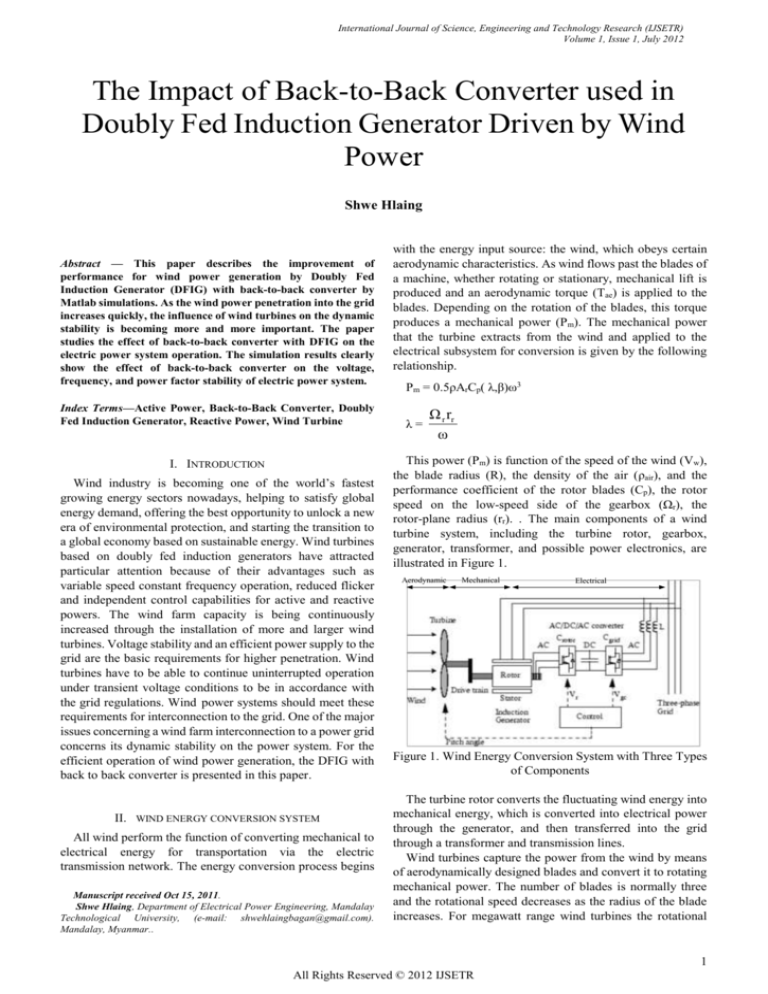
International Journal of Science, Engineering and Technology Research (IJSETR)
Volume 1, Issue 1, July 2012
The Impact of Back-to-Back Converter used in
Doubly Fed Induction Generator Driven by Wind
Power
Shwe Hlaing
Abstract — This paper describes the improvement of
performance for wind power generation by Doubly Fed
Induction Generator (DFIG) with back-to-back converter by
Matlab simulations. As the wind power penetration into the grid
increases quickly, the influence of wind turbines on the dynamic
stability is becoming more and more important. The paper
studies the effect of back-to-back converter with DFIG on the
electric power system operation. The simulation results clearly
show the effect of back-to-back converter on the voltage,
frequency, and power factor stability of electric power system.
Index Terms—Active Power, Back-to-Back Converter, Doubly
Fed Induction Generator, Reactive Power, Wind Turbine
I. INTRODUCTION
Wind industry is becoming one of the world’s fastest
growing energy sectors nowadays, helping to satisfy global
energy demand, offering the best opportunity to unlock a new
era of environmental protection, and starting the transition to
a global economy based on sustainable energy. Wind turbines
based on doubly fed induction generators have attracted
particular attention because of their advantages such as
variable speed constant frequency operation, reduced flicker
and independent control capabilities for active and reactive
powers. The wind farm capacity is being continuously
increased through the installation of more and larger wind
turbines. Voltage stability and an efficient power supply to the
grid are the basic requirements for higher penetration. Wind
turbines have to be able to continue uninterrupted operation
under transient voltage conditions to be in accordance with
the grid regulations. Wind power systems should meet these
requirements for interconnection to the grid. One of the major
issues concerning a wind farm interconnection to a power grid
concerns its dynamic stability on the power system. For the
efficient operation of wind power generation, the DFIG with
back to back converter is presented in this paper.
II. WIND ENERGY CONVERSION SYSTEM
All wind perform the function of converting mechanical to
electrical energy for transportation via the electric
transmission network. The energy conversion process begins
Manuscript received Oct 15, 2011.
Shwe Hlaing, Department of Electrical Power Engineering, Mandalay
Technological University, (e-mail: shwehlaingbagan@gmail.com).
Mandalay, Myanmar..
with the energy input source: the wind, which obeys certain
aerodynamic characteristics. As wind flows past the blades of
a machine, whether rotating or stationary, mechanical lift is
produced and an aerodynamic torque (Tae) is applied to the
blades. Depending on the rotation of the blades, this torque
produces a mechanical power (Pm). The mechanical power
that the turbine extracts from the wind and applied to the
electrical subsystem for conversion is given by the following
relationship.
Pm = 0.5ρArCp( λ,β)ω3
λ=
Ω r rr
ω
This power (Pm) is function of the speed of the wind (Vw),
the blade radius (R), the density of the air (ρair), and the
performance coefficient of the rotor blades (Cp), the rotor
speed on the low-speed side of the gearbox (Ωr), the
rotor-plane radius (rr). . The main components of a wind
turbine system, including the turbine rotor, gearbox,
generator, transformer, and possible power electronics, are
illustrated in Figure 1.
Aerodynamic
Mechanical
Electrical
Figure 1. Wind Energy Conversion System with Three Types
of Components
The turbine rotor converts the fluctuating wind energy into
mechanical energy, which is converted into electrical power
through the generator, and then transferred into the grid
through a transformer and transmission lines.
Wind turbines capture the power from the wind by means
of aerodynamically designed blades and convert it to rotating
mechanical power. The number of blades is normally three
and the rotational speed decreases as the radius of the blade
increases. For megawatt range wind turbines the rotational
1
All Rights Reserved © 2012 IJSETR
International Journal of Science, Engineering and Technology Research (IJSETR)
Volume 1, Issue 1, July 2012
speed will be 10-15 rpm. The weight-efficient way to convert
the low-speed, high-torque power to electrical power is to use
a gearbox and a generator with standard speed. The gearbox
adapts the low speed of the turbine rotor to the high speed of
the generator. The gearbox may be not necessary for
multipole generator systems.
The generator converts the mechanical power into
electrical energy, which is fed into a grid through possibly a
power electronic converter, and a transformer with circuit
breakers and electricity meters. The connection of wind
turbines to the grid is possible at low voltage, medium
voltage, high voltage, and even at the extra high voltage
system since the transmittable power of an electricity system
usually increases with increasing the voltage level. While
most of the turbines are nowadays connected to the medium
voltage system, large offshore wind farms are connected to
the high and extra high voltage level.
III. WIND TURBINE CONCEPTS AND GENERATOR TYPES
Referring to the rotation speed, wind turbine concepts can
be classified into fixed speed, limited variable speed and
variable speed. For variable speed wind turbines, based on the
rating of power converter related to the generator capacity,
they can be further classified into wind generator systems with
a partial-scale and a full-scale power electronic converter. In
addition, considering the drive train components, the wind
turbine concepts can be classified into geared-drive and
direct-drive wind turbines. In geared-drive wind turbines, one
conventional configuration is a multiple-stage gear with a
high-speed generator; the other one is the multibrid concept
which has a single-stage gear and a low-speed generator.
A. Fixed-speed Concept
The fixed speed wind generator systems have been used
with a multiple-stage gearbox and a SCIG directly connected
to the grid through a transformer as illustrated in Figure 2.
Because the SCIG operates only in a narrow range around the
synchronous speed, the wind turbine equipped with this type
of generator is often called the fixed-speed wind generator
system. Smoother grid connection was also achieved by
incorporating a soft-starter. Furthermore, a pole-changeable
SCIG has been used, which leads two rotation speeds.
The well-known advantages of SCIG are it is robust, easy
and relatively cheap for mass production. In addition, it
enables stall-regulated machines to operate at a constant
speed when it is connected to a large grid, which provides a
stable control frequency. Although the stall control method is
usually used in combination with the fixed speed SCIG for
power control, the active stall control or pitch control have
also been applied.
B. Limited Variable Speed Concept
The limited variable speed concept with a multiple-stage
gearbox is also known as the Optislip concept. This wind
turbine concept uses a wound rotor induction generator
(WRIG) with variable rotor resistance by means of a power
electronic converter and the pitch control method, as shown in
Figure 3.
Figure 3. Scheme of a limited variable speed concept with
WRIG system (Optislip)
The stator of WRIG is directly connected to the grid,
whereas the rotor winding is connected in series with a
controlled resistor. Variable-speed operation can be achieved
by controlling the energy extracted from the WRIG rotor;
however, this power must be dissipated in the external
resistor. With the increase in variable speed range, a higher
slip means a high power extracted by the rotor, and the lower
generator efficiency, so that the rating of the resistor must also
be higher. Therefore the dynamic speed control range
depends on the size of the variable rotor resistance, and the
energy extracted from the external resistor is also dumped as
heat loss in the controllable rotor resistance. A typical limited
variable speed range is less than 10% above the synchronous
speed.
C. Variable Speed Concept with a Partial Scale Power
Converter
This configuration is known as the DFIG concept, which
corresponds to a variable speed wind turbine with a WRIG
and a partial-scale power converter on the rotor circuit, as
illustrated in Figure 4. The stator is directly connected to the
grid, whereas the rotor is connected through a power
electronic converter. The power converter controls the rotor
frequency and thus the rotor speed. This concept supports a
wide speed range operation, depending on the size of the
frequency converter. Typically, the variable speed range is
30% around the synchronous speed. The rating of the power
electronic converter is only 25 to 30% of the generator
capacity, which makes this concept attractive and popular
from an economic point of view.
Figure 4. Scheme of a variable speed concept with D FIG
system
IV. WIND TURBINE WITH DFIG
Figure 2. Scheme of a fixed speed concept with SCIG
system
Generally the wind turbines (WT) can either operate at
fixed speed or variable speed. For variable speed systems
2
All Rights Reserved © 2012 IJSETR
International Journal of Science, Engineering and Technology Research (IJSETR)
Volume 1, Issue 1, July 2012
with limited variable-speed range (±30% of synchronous
speed), the DFIG can be a cost effective solution. The DFIG
converter consists of two converters that are connected
“back-to-back” as in Figure; machine-side converter and grid
side converter. Between the converter, a dc-link capacitor is
placed as energy storage to keep the dc-link voltage variations
(or ripple) small.
With the machine side converter, it is possible to control
the torque or the speed of the DFIG, and also the power factor
at the stator terminals, while the main objective for the
grid-side converter is to keep the dc-link voltage constant.
VI. BACK TO BACK CONVERTER
The power electronic back to back converter also known as
AC-DC-AC converter system is the most common
configuration used to interface the variable speed DFIG wind
turbines to the grid. This converter system is also called as the
back-to-back Voltage Source Converter (VSC) configuration.
Few of the advantages of the Back-to-Back Converters (BBC)
are as follows:
It is a well-established technology and many
manufacturers produce components especially designed
for the BBC’s.
decoupling of the two VSC’s through a capacitor
allows for individual control of both the rotor-side
and grid-side converters.
Figure 5. Variable-Speed Wind Turbine with a Doubly-Fed
Induction Generator (DFIG)
V. OPERATING PRINCIPLE OF DFIG WITH BACK-TO-BACK
CONVERTER
The stator is directly connected to the AC mains, while the
wound rotor is fed from the Power Electronics Converter via
slip rings to allow DIFG to operate at a variety of speeds in
response to changing wind speed. Indeed, the basic concept is
to interpose a frequency converter between the variable
frequency induction generator and fixed frequency grid. The
DC capacitor linking stator and rotor side converters
allows the storage of power from induction generator for
further generation. To achieve full control of grid current, the
DC-link voltage must be boosted to a level higher than the
amplitude of grid line-to-line voltage. The slip power can
flow in both directions, i.e. to the rotor from the supply and
from supply to the rotor and hence the speed of the machine
can be controlled from either rotor- or stator-side converter in
both super and sub-synchronous speed ranges.
The AC/DC/AC converter is basically a PWM converter
which uses sinusoidal PWM technique to reduce the
harmonics present in the wind turbine driven DFIG system.
Here Crotor is rotor side converter and Cgrid is grid side
converter. Crotor and Cgrid have the capability for generating or
absorbing power and could be used to control the power or the
voltage at the grid terminals.
Figure 6. Basic Operating Principle of DFIG
Figure 7. Equivalent Circuit of the Back-to-Back
Converter
The back-to-back converter configuration shown in Figure
7 is a bidirectional power electronic IGBT converter
consisting of two voltage source converters connected back to
back. It consists of a three-phase controlled rectifier and
a three-phase controlled inverter, coupled through a
capacitor, called the dc link. Since, the back-to-back
converter configuration is implemented with the
variable-speed DFIG, the rectifier is also called as the
Grid-Side Converter (GSC), and the inverter is also called as
the Rotor-Side Converter (RSC).
VII. SIMULINK MODEL FOR THE BACK-TO-BACK PWM
CONVERTER
A simulation model for back to back converter controlled
DFIG system is developed using components from the Power
System’s Blockset (SimPower). This is a particularly useful
add-on to Simulink that provides models for a wide range of
power electronic devices and control structures. Most of the
blocks used in the design are available in the standard
Simulink library. The simulation model is executed with
Matlab/Simulink 2013a version. The simulation model for
Back to Back Converter Controlled DFIG is executed with
Matlab/Simulink 2013a version. This simulation model is
constructed to control Back to Back Converter Controlled
DFIG in various condition. Therefore various operation
conditions are created in this simulation as follow:
(i)Operation at below rated wind speed
(ii) Operation at above rated wind speed
At each operation, the various measurements are carried
out at DC sides as well as AC sides. The main measurements
3
All Rights Reserved © 2012 IJSETR
International Journal of Science, Engineering and Technology Research (IJSETR)
Volume 1, Issue 1, July 2012
are (i) the DC link voltage and current measurement, (ii) the
input AC voltage and current measurements from stator and
rotor side and (iii) the back to back converter measurement.
The Simulink block diagram is constructed as the system
described in Figure 8. It consists of AC input section, DC link
section, the converter, PWM controller and measurement
systems.
Figure 10. Power delivered from Stator Side at 9 m/s Wind
Speed
Figure 8. Simulink Model for Back to Back Converter
Controlled DFIG
VII. SIMULATIONS RESULTS
The proposed function models have been implemented
using the DFIG wind power system using back-to-back PWM
converters. The power rating of the DFIG is 1.5 MW, the grid
voltage is 33 kV, the grid frequency is 50 Hz, and the dc-link
voltage is 1150 V, the switching frequency for both converter
is 2 kHz and the simulation period is set as 6 sec. The DFIG
system is connected to the grid through a transformer with
turn ratio of 33/0.69. The simulation results are shown in
Figure 9 to 16. The results show active and reactive power
provided from rotor side, stator side, DFIG at variable wind
speed. The power provided from rotor side, stator side are
depend on dc-link voltage of back-to-back converter. Since
the dc-link voltage is nearly equal to 1150 V, thus
back-to-back converter is acceptable at variable wind speed
for power system.
Figure 11. Power delivered from DFIG at 9 m/s Wind Speed
Figure 12. DC Bus Voltage at 9 m/s Wind Speed
Figure 9. Power delivered from Rotor Side at 9 m/s Wind
Speed
Figure 13. Power delivered from Rotor Side at 13 m/s Wind
Speed
4
All Rights Reserved © 2012 IJSETR
International Journal of Science, Engineering and Technology Research (IJSETR)
Volume 1, Issue 1, July 2012
speed, the power factor is poor compared to rated wind speed
condition. DC bus voltage is 1143 V, it is nearly equal to 1150
V. So, it is acceptable for the back to back converter. At 13
m/s above rated wind speed is 1160 V. So, it is also acceptable
for the back to back converter.
ACKNOWLEDGMENT
The author wishes to express her deepest gratitude to her
teachers, Department of Electrical Power Engineering,
Mandalay Technological University. The author also wishes
to extend special thanks to her parent, her friends for their
supports and help. Similar thanks to all for their instructions
and willingness to share their ideas throughout all those years
of study.
Figure 14. Power delivered from Stator Side at 13 m/s Wind
Speed
REFERENCES
Goldind. E.W, “The Generation of Electricity by Wind Power”, E &
F.N Spon Limited, 22 Henrietta Street, London. 1995.
[2] E. Muljadi, C.P. “Wind Farm Power System Model Development,”
World Renewable Energy Congress VIII, Colorado, Butterfield. 2004.
[3] K. Johnsen, B. Eliasson, “SIMULINK Implementation of Wind Farm
Model for use in Power System Studies,” Nordic Wind Power
Conference, Chalmers University of Technology,2004.
[4] LEONHARD, W. “Control of electrical drives”Springer-Verlag, 1985.
[5] JONES, S.R., and JONES, R.“Control strategy for
Sinusoidal
supply side converters”, IEEColloquium on Developments in real
timeControl for induction motor drives. Digest 1993/024, February
1993.
[6] CARDICI, I., and ERMIS, M.,“Double-outputInduction generator
operating at sub synchronous andsuper synchronous speed:steady
statePerformance optimization and wind energy
recovery”,IEE
proc. B, 1992, 139, (5), pp.429- 442
[7] MITSUTOSHI, Y., and MOTOYOSHI, O., “Active and reactive power
control for doubly fed wound rotor induction generator”, IEE Trans.
Power Electron, 6, (4), pp. 624-629,1991.
[8] R .Erickson. Fundamentals of PowerElectronics. Kluwer, 1997.
Shwe Hlaing received her B.E (Electrical power) degree from
Technological University, in 2009 and now pursuing M.E (Electrical Power)
at Mandalay Technological University.
[1]
Figure 15. Power delivered from DFIG at 13 m/s Wind Speed
Figure 16. DC Bus Voltage at 13 m/s Wind Speed
VIII. CONCLUSION
Simulation studies have shown that the application of
DFIG with back to back converter can significantly improve
the wind turbines performance. The interconnection of wind
farms to grids also influences the safety of wind turbine
generators. The dynamic performance of wind farms in a
power grid is improved by the application of a back to back
converter. The back to back converter helps to provide better
power generation characteristics and stability under various
wind speeds. This paper examines the application of DFIG
with back to back converter in wind farms to stabilize the grid
voltage and to improve power flow in the system under
various wind speed condition. At 9 m/s below rated wind
5
All Rights Reserved © 2012 IJSETR

